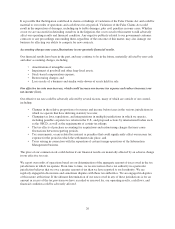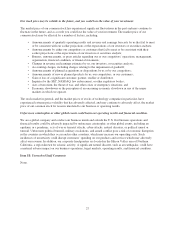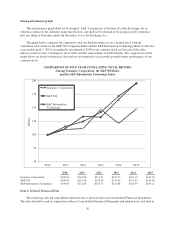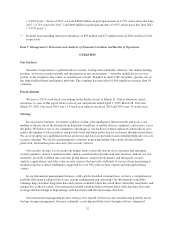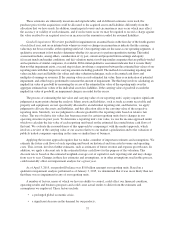Symantec 2015 Annual Report Download - page 114
Download and view the complete annual report
Please find page 114 of the 2015 Symantec annual report below. You can navigate through the pages in the report by either clicking on the pages listed below, or by using the keyword search tool below to find specific information within the annual report.We expect our distributors and resellers to maintain adequate inventory of consumer packaged products to
meet future customer demand, which is generally four or six weeks of customer demand based on recent buying
trends. We ship product to our distributors and resellers at their request and based on valid purchase orders. Our
distributors and resellers base the quantity of orders on their estimates to meet future customer demand, which
may exceed the expected level of a four or six week supply. We offer limited rights of return if the inventory held
by our distributors and resellers is below the expected level of a four or six week supply. We estimate reserves
for product returns as described below. We typically offer liberal rights of return if inventory held by our
distributors and resellers exceeds the expected level. Because we cannot reasonably estimate the amount of
excess inventory that will be returned, we primarily offset deferred revenue against trade accounts receivable for
the amount of revenue in excess of the expected inventory levels.
Arrangements for maintenance, subscriptions, managed security services and SaaS offerings are generally
offered to our customers over a specified period of time, and we recognize the related revenue ratably over the
maintenance, subscription, or service period.
Reserves for product returns. We reserve for estimated product returns as an offset to revenue or deferred
revenue based primarily on historical trends. We fully reserve for obsolete products in the distribution channels
as an offset to deferred revenue. Actual product returns may be different than what was estimated. These factors
and unanticipated changes in the economic and industry environment could make actual results differ from our
return estimates.
Reserves for rebates. We estimate and record reserves for channel and end-user rebates as an offset to
revenue or deferred revenue. For consumer products that include content updates, rebates are recorded as a
ratable offset to revenue or deferred revenue over the term of the subscription. Our estimated reserves for channel
volume incentive rebates are based on distributors’ and resellers’ actual performance against the terms and
conditions of volume incentive rebate programs, which are typically entered into quarterly. Our reserves for end-
user rebates are estimated based on the terms and conditions of the promotional programs, actual sales during the
promotion, the amount of actual redemptions received, historical redemption trends by product and by type of
promotional program, and the value of the rebate. We also consider current market conditions and economic
trends when estimating our reserves for rebates. If actual redemptions differ from our estimates, material
differences may result in the amount and timing of our net revenues for any period presented.
Valuation of goodwill, intangible assets and long-lived assets
Business combination valuations. When we acquire businesses, we allocate the purchase price to tangible
assets and liabilities and identifiable intangible assets acquired. Any residual purchase price is recorded as
goodwill. The allocation of the purchase price requires management to make significant estimates in determining
the fair values of assets acquired and liabilities assumed, especially with respect to intangible assets. These
estimates are based on information obtained from management of the acquired companies and historical
experience. These estimates can include, but are not limited to:
• cash flows that an asset is expected to generate in the future;
• expected costs to develop the in-process research and development into commercially viable products
and estimated cash flows from the projects when completed;
• the acquired company’s brand and competitive position, as well as assumptions about the period of
time the acquired brand will continue to be used in the combined company’s product portfolio;
• cost savings expected to be derived from acquiring an asset; and
• discount rates.
36


